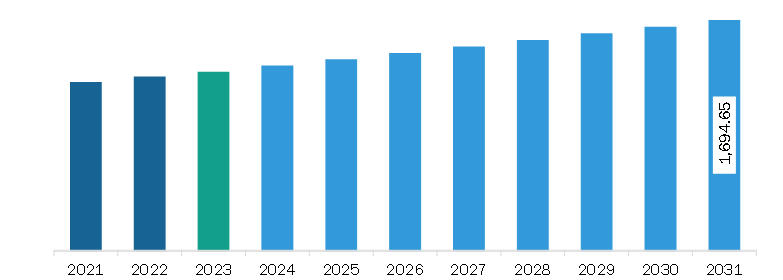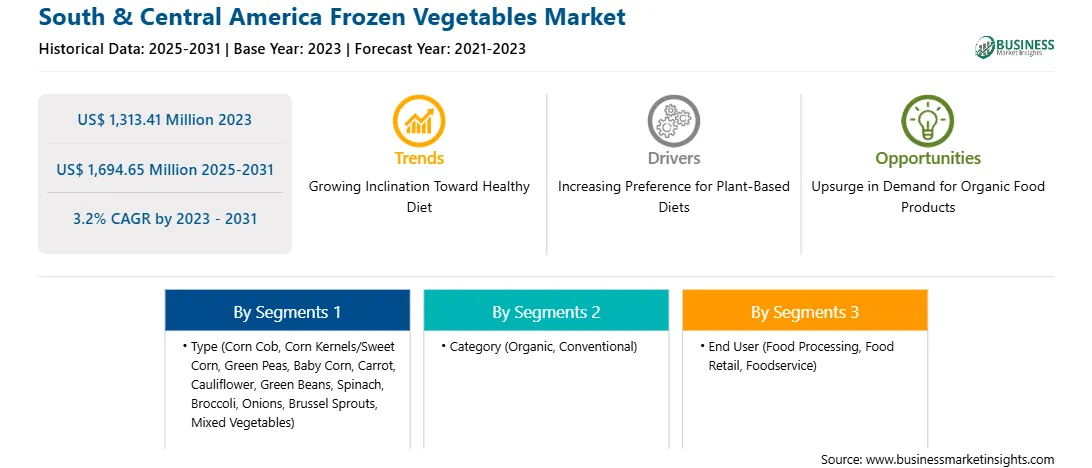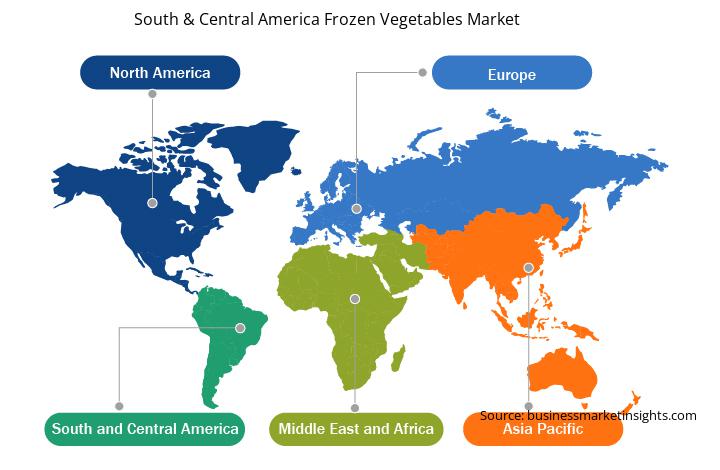The South & Central America frozen vegetables market was valued at US$ 1,313.41 million in 2023 and is expected to reach US$ 1,694.65 million by 2031; it is estimated to register a CAGR of 3.2% from 2023 to 2031.
Consumers are increasingly prioritizing organic food products, including organic frozen vegetables, owing to the growing awareness regarding the adverse impact of conventional farming practices on the environment and rising concerns about pesticide residues in food products. Consumers perceive organic products as healthier, safer, and more environmentally sustainable food options. As a result, manufacturers and retailers are expanding their organic product offerings and investing in sourcing organic ingredients to cater to the growing consumer demand. Consumers are becoming increasingly aware of organic produce's health benefits and are seeking organic options as part of their dietary preferences.
Growing interest in sustainable farming practices and rising support for local farmers who produce organic vegetables are a few factors that impact the demand for organic frozen vegetables across the globe, especially in developed countries. As a result, manufacturers are introducing organic frozen vegetables sourced from certified organic farms to cater to consumers' demand for healthier and environmentally friendly food choices. This indicates a broader global movement toward organic agriculture and sustainable food systems, with consumers increasingly consuming organic options such as frozen organic vegetables.
The growing consumer demand for organic products can increase sales and market share, but it also requires investment in organic certification, sourcing, and production processes. Companies must comply with strict organic standards and maintain transparency and traceability throughout the supply chain to retain consumer trust. Further, as the scope of organic food products continues to evolve, there is a need for innovation in product offerings, packaging, and marketing strategies to differentiate organic frozen vegetables and capitalize on this growing trend. Thus, the rising demand for organic food products is expected to create a significant opportunity for companies operating in the frozen vegetables market during the forecast period.
The demand for frozen food products, such as frozen vegetables and ready meals, in South & Central America is rising owing to the advancement in the food retail sector, increasing consumer access to distinct frozen food products, and changing consumer lifestyles. Frozen vegetables offer an attractive ingredient option to foodservice operators due to their long shelf life and ease of preparation compared to fresh produce. As a result of rising tourism, investments in the food service sector are increasing. In January 2023, MARAEY tourist residential enterprise signed an agreement with Marriott International Inc. to build three distinct hotels in Rio de Janeiro, Brazil, with an investment of ~US$ 360 million. The growth of the tourism industry and rising hotel establishments is expected to drive market growth. `In May 2023, Faena Luxury Hotel announced the opening of a luxury complex in São Paulo, Brazil, with 100 rooms, a cultural center, and 140 luxury residential units. In addition, the expansion of modern retail channels such as supermarkets and hypermarkets make frozen vegetables accessible to consumers. As the region continues to urbanize and adopt modern lifestyles, the frozen vegetables market in South & Central America is likely to witness sustained growth in the coming years.
Strategic insights for the South & Central America Frozen Vegetables provides data-driven analysis of the industry landscape, including current trends, key players, and regional nuances. These insights offer actionable recommendations, enabling readers to differentiate themselves from competitors by identifying untapped segments or developing unique value propositions. Leveraging data analytics, these insights help industry players anticipate the market shifts, whether investors, manufacturers, or other stakeholders. A future-oriented perspective is essential, helping stakeholders anticipate market shifts and position themselves for long-term success in this dynamic region. Ultimately, effective strategic insights empower readers to make informed decisions that drive profitability and achieve their business objectives within the market. The geographic scope of the South & Central America Frozen Vegetables refers to the specific areas in which a business operates and competes. Understanding local distinctions, such as diverse consumer preferences (e.g., demand for specific plug types or battery backup durations), varying economic conditions, and regulatory environments, is crucial for tailoring strategies to specific markets. Businesses can expand their reach by identifying underserved areas or adapting their offerings to meet local demands. A clear market focus allows for more effective resource allocation, targeted marketing campaigns, and better positioning against local competitors, ultimately driving growth in those targeted areas.
South & Central America Frozen Vegetables Strategic Insights

South & Central America Frozen Vegetables Report Scope
Report Attribute
Details
Market size in 2023
US$ 1,313.41 Million
Market Size by 2031
US$ 1,694.65 Million
CAGR (2023 - 2031) 3.2%
Historical Data
2021-2023
Forecast period
2025-2031
Segments Covered
By Type
By Category
By End User
Regions and Countries Covered
South & Central America
Market leaders and key company profiles
South & Central America Frozen Vegetables Regional Insights

The South & Central America frozen vegetables market is categorized into type, category, end user, and country.
By type, the South & Central America frozen vegetables market is segmented into corn cob, corn kernels/sweet corn, green peas, baby corn, carrot, cauliflower, green beans, spinach, broccoli, onions, brussel sprouts, mixed vegetables, and others. The others segment held the largest share of the South & Central America frozen vegetables market share in 2023.
In terms of category, the South & Central America frozen vegetables market is bifurcated into organic and conventional. The conventional segment held a larger share of the South & Central America frozen vegetables market share in 2023.
Based on end user, the South & Central America frozen vegetables market is segmented into food processing, food retail, and foodservice. The food retail segment held the largest share of the South & Central America frozen vegetables market share in 2023.
Based on country, the South & Central America frozen vegetables market is segmented into Brazil, Argentina, and the Rest of South & Central America. The Rest of South & Central America segment held the largest share of South & Central America frozen vegetables market in 2023.
Alasko Food Inc.; Ardo Foods NV; B&G Foods; Bonduelle SA; Dawtona Frozen; General Mills Inc; Goya Foods Inc; Grupo Virto; Hanover Foods; La Fe Foods; McCain Foods Ltd; Mondial Foods BV; Mother Dairy Fruit & Vegetable Pvt. Ltd; Seneca Foods Corp; and Simplot Global Food are some of the leading companies operating in the South & Central America frozen vegetables market.
The South & Central America Frozen Vegetables Market is valued at US$ 1,313.41 Million in 2023, it is projected to reach US$ 1,694.65 Million by 2031.
As per our report South & Central America Frozen Vegetables Market, the market size is valued at US$ 1,313.41 Million in 2023, projecting it to reach US$ 1,694.65 Million by 2031. This translates to a CAGR of approximately 3.2% during the forecast period.
The South & Central America Frozen Vegetables Market report typically cover these key segments-
The historic period, base year, and forecast period can vary slightly depending on the specific market research report. However, for the South & Central America Frozen Vegetables Market report:
The South & Central America Frozen Vegetables Market is populated by several key players, each contributing to its growth and innovation. Some of the major players include:
The South & Central America Frozen Vegetables Market report is valuable for diverse stakeholders, including:
Essentially, anyone involved in or considering involvement in the South & Central America Frozen Vegetables Market value chain can benefit from the information contained in a comprehensive market report.